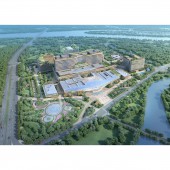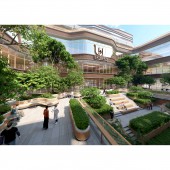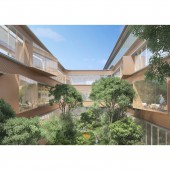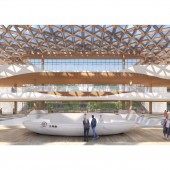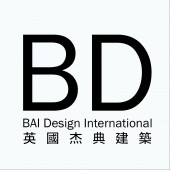Midea Heyou International Hospital by Bai Yu |
Home > Winners > #127351 |
 |
|
||||
| DESIGN DETAILS | |||||
| DESIGN NAME: Midea Heyou PRIMARY FUNCTION: International Hospital INSPIRATION: The design is inspired by the ancient Lingnan water townscape of Shunde, with its crisscrossing rivers, to create a "garden hospital" that will live in symbiosis with nature. The interior incorporates landscape features such as courtyards and sky gardens, bringing sunlight, fresh air and greenery into the hospital, making the hospital as a whole resemble an urban garden. Nurture and growth are the most beautiful themes in nature, and the design allows the building to grow into nature. UNIQUE PROPERTIES / PROJECT DESCRIPTION: Heyou International Hospital will serve as a comprehensive medical center, shifting from a traditional "treatment-led& OPERATION / FLOW / INTERACTION: The masterplan adopts the concept of "one axis, two belts, three zones, eight scenes and one pictorial landscape", allowing the medical use and function to fully integrate with nature. The landscape axes are introduced to open up view corridors, along which medical spaces can have a symbiotic relationship with nature, a healing environment is thus created, making the medical complex as a whole a graceful health park that can be experienced. The design reflects the 'whole life cycle' concept, with a planned 'plug-in' modular layout of medical units that can grow with future needs. PROJECT DURATION AND LOCATION: The project is located in Shunde District, Foshan City, Guangdong Province, China. Design work has commenced in 2020 and construction has started in early 2021, with the foundation stone laid in November 2020. Construction is expected to be completed by the end of 2023, with the official opening and operation of the project expected to take place in 2024. FITS BEST INTO CATEGORY: Architecture, Building and Structure Design |
PRODUCTION / REALIZATION TECHNOLOGY: The integration of technological innovation and the return of technology to nature: By adopting cutting edge structural design and materials to reduce energy consumption and create a zero carbon emission hospital, and to allow energy saving technology and health care to co-exist. The roof is integrated with curtain wall and photo-voltaic/solar energy system, signifying the idea of returning of technology to nature. The main facade adopts a dia-grid structural system - a high-tech approach to construction, and its unique facade creates an identity in the medical and health sector. SPECIFICATIONS / TECHNICAL PROPERTIES: The project has a total site area of 152,234sqm, with a total GFA of about 260,000sqm in phase I (planned capacity of 1,000 beds), and a total planned GFA of about 380,000sqm in the long term (planned capacity of 1,500 beds) and a daily outpatient capacity of about 6,500 people. Phase I consists of a medical complex (133,126sqm), an office building (29,700sqm) and a International Medical Centre IMC (22,656sqm). The medical complex covers emergency, outpatient, medical technology, proton therapy, nuclear medicine and radiotherapy, critical care, rehabilitation etc.. TAGS: Architecture, Hospital, Medical, Health, Healing, Garden, Art, Nature, Energy-saving, RESEARCH ABSTRACT: The outbreak of the corona virus has brought about a considerable impact on all industries and has sounded the alarm for the environmental safety of design for medical buildings, as medical buildings are projects not only for the diagnosis and treatment of diseases and the maintenance of human health, but also for the key prevention and control sites of public health emergencies. For the future development of medical building design, combined with the design practice of this project, the project team have conducted an in-depth study on a number of design aspects. CHALLENGE: Medical buildings are always subject to changes in medical processes and medical equipment, so a more structured layout and modular 'plug-in' design is more conducive to adapting to the changes. The innovation and challenge of medical architecture is reflected in the project's 'whole life cycle' architectural concept, where design is no longer aimed at the current optimum of building and function, but rather at adapting to the changing use and function of the hospital. ADDED DATE: 2021-06-23 10:37:45 TEAM MEMBERS (1) : IMAGE CREDITS: Bai Yu, 2021. |
||||
| Visit the following page to learn more: http://www.baidesign.co.uk/437 | |||||
| AWARD DETAILS | |
 |
Midea Heyou International Hospital by Bai Yu is Winner in Architecture, Building and Structure Design Category, 2021 - 2022.· Read the interview with designer Bai Yu for design Midea Heyou here.· Press Members: Login or Register to request an exclusive interview with Bai Yu. · Click here to register inorder to view the profile and other works by Bai Yu. |
| SOCIAL |
| + Add to Likes / Favorites | Send to My Email | Comment | Testimonials | View Press-Release | Press Kit |
Did you like Bai Yu's Architecture Design?
You will most likely enjoy other award winning architecture design as well.
Click here to view more Award Winning Architecture Design.


